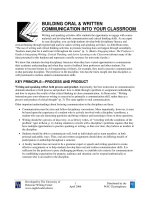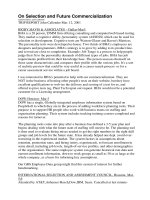Tài liệu TRADE:INSTITUTIONS AND IMPACT- Why and how do countries trade? pdf
Bạn đang xem bản rút gọn của tài liệu. Xem và tải ngay bản đầy đủ của tài liệu tại đây (360.53 KB, 9 trang )
Fulbright Economics Teaching Program
2006-2007
Trade: Institutions and impact
Ari Kokko 1
Lecture 1
Ari Kokko
TRADE:
INSTITUTIONS AND IMPACT
Why and how do countries trade?
Outline and schedule
Ari Kokko
Why do countries trade?
•
Get goods and services that cannot be
produced at home
•
To accumulate gold
•
Get cheaper goods and services
•
Efficiency and growth
•
Different theories and policies for different
motives
Fulbright Economics Teaching Program
2006-2007
Trade: Institutions and impact
Ari Kokko 2
Lecture 1
Ari Kokko
Gains from trade:
the simple view
•
Clear gains if countries are strong in
different areas: absolute advantages
•
Less obvious - but undisputed - gains even
if one country is “better” in all areas:
comparative advantages
Ari Kokko
Absolute advantages
Motorbikes
Rice
Vietnam 20 10
Laos 10 20
Labor requirements for one unit of output
Fulbright Economics Teaching Program
2006-2007
Trade: Institutions and impact
Ari Kokko 3
Lecture 1
Ari Kokko
Comparative advantages
Motorbikes
Rice
Vietnam 20 10
Laos 100 20
Labor requirements for one unit of output
Ari Kokko
Comparative advantages
Trade is profitable as soon as relative prices
differ between countries
Why are there differences in relative prices?
Classical and neoclassical theory:
– technology differences (Adam Smith 1776 /
David Ricardo 1815)
– differences in factor endowments (Heckscher-
Ohlin 1930)
Fulbright Economics Teaching Program
2006-2007
Trade: Institutions and impact
Ari Kokko 4
Lecture 1
Ari Kokko
Policy conclusions:
neoclassical theory
Free trade and specialization is optimal
pattern of comparative advantages is given by
nature
all industries are equally “desirable”
International framework should support
development of free trade
unilateral liberalization more difficult because
of protectionist interest groups and lack of
coordination
Ari Kokko
Institutions:
Bretton-Woods solutions
Four cornerstones of international economy
after WWII to support growth of free trade
– International Bank for Reconstruction and
Development
– International Monetary Fund
– International Trade Organization
– Price stabilization fund
Fulbright Economics Teaching Program
2006-2007
Trade: Institutions and impact
Ari Kokko 5
Lecture 1
Ari Kokko
But why is world trade
not free?
•
Protectionism leads to higher prices, lower
consumption, and lower welfare both at
home and abroad...
•
…so why is there still a lot of
protectionism?
Ari Kokko
Unequal gains from trade
at the micro level
•
Interest groups matter: trade benefits some
groups but hurts others
• trade raises the rewards of a country’s abundant
factor of production and reduces the rewards of
the scarce factor (Stolper-Samuelson theorem)
• the groups that lose may oppose free trade
• the transition to free trade may have
troublesome social consequences









